By Peter Hossli (text) and Charly Kurz (photos)
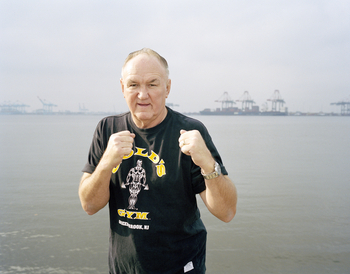
Chuck Wepner, the merchant in wines and liquors, opens the top drawer of his old wooden desk, grabs a couple of business cards and shows them to his visitors. “Not everyone can show you this,” he says. His pride of the “two successes that have formed me” is clearly visible. As the perceived underdog, he did lose the world title-match against Ali in the end, on the 24th of March 1975, but not after sending the former Champion to the canvas with a direct straight hook right under his heart. Another underdog witnessed the spectacular fight, the not very talented actor Sylvester Stallone. He then locked himself for three consecutive days and nights in his shabby apartment to write the script for ‘Rocky’, the famous box-movie that made Stallone one of the richest men in Hollywood.
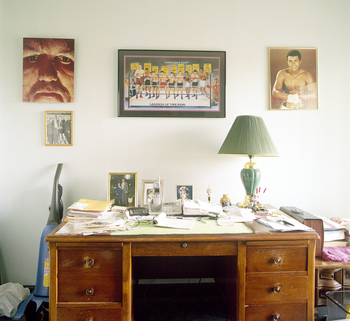
Three years ago, his wife made him deposit a 15 Million dollar claim. He did not use the argu-ment that Stallone had stolen his life-story, but protested against the usage of his name with-out permission in the context of promotion activities, as Stallone always tells on DVD’s and dur-ing performances that has inspired him. “Without my story, ‘Rocky’ would have been nothing but a tale,” says Wepner. “Nobody would believe it.” Last August, Stallone and Wepner made an agreement. The star has paid the boxer a sum of money, the amount to be kept secret, and is recognizing Wepner as the rightful Rocky.
What is a late satisfaction for Wepner is perfect timing for Stallone. With “Rocky Balboa” he is launching the sixth and presumably last episode of the film-series that has grossed over 3 billion dollars worldwide, into the cinemas. A pending court case could have harmed the festivities around the première, to which Wepner was not invited. He will see the movie in a local theatre. “Some time in the afternoon, when the place is half empty.”
He is not expecting a great deal anyway. “It is ridiculous that Stallone returns to the ring to fight for the title at 61 years of age.” He stopped at 40 in order to “be able to speak and listen normally when I would be old.” Most of the boxers from his generation now have “soft brains”, he says. He has kept fit, physically as well as mentally, because he trained hard, punched force-fully and fought fearless. That was all he had. Wepner was – like Rocky in the film – a white boxer with a great heart and a little bit of talent. A giant without grace. He typifies his style as “Gang Warfare”. “The bell would chime and I threw myself into battle.” He scared other boxers by just running towards them.
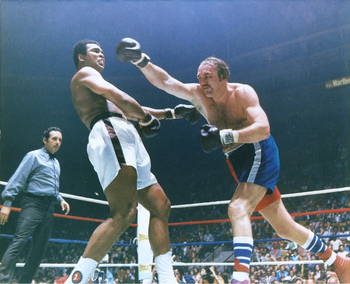
He was long past his pinnacle when a loudmouthed and shrewd guy with an enormous hairdo entered the boxing scene. Don King had organized the legendary ‘Rumble in the Jungle’ in October 1974, the fight between Muhammad Ali and George Foreman in what was then known as Zaire. Ali won by surprise. As promoter, King lost millions of dollars, which he had borrowed from the Mafia. The next match had to yield a profit without fail, says Wepner, or King would have “dis-appeared on the bottom of the sea.” To save his neck, King needed an attractive duel that would appeal to the Zeitgeist. Consequently, he made the superior black champion of the world encounter a white outsider.
Being the best white heavyweight boxer around, Wepner got selected – while no one took him serious. “I was clearly the underdog,” he says. “Ali had just beaten Foreman in a difficult fight, so he was looking for an opponent he could slaughter effortlessly.” The betting quotes were at 30 to 1. The candidacy of Wepner was regarded as a joke. “Someone like him is supposed to stand for white America?” mocked Ali. Wepner had no problems with all that. “Ali was underestimating me while I was in the form of my life.” For the first time ever, he trained all day long. Don King had invited him to stay in a luxurious hotel in the Catskills, north of New York. He ran, he ate, he boxed, and he slept.
Then, the fight happened on the 24th of March 1975 in the Coliseum of Cleveland. Wepner launched himself as a wild bull on to Ali, who danced around his attacker avoiding the blows aimed at him, and kept his distance – until the ninth round. Ali lost his balance; Wepner hit him in the chest. Ali tumbled, fell and waited for eight counts. “It was a perfect punch,” says Wep-ner. Fully excited he ran to the corner and told his manager: “Get the motor running, we are driving to the bank, we are millionaires!” “You’d better turn around,” was the answer. “Ali is back on his feet and angry as hell.” Now, Ali struck without mercy, breaking Wepner’s nose and jaw in the process. Blood ran in his eyes. The referee stopped the beating in the last round.
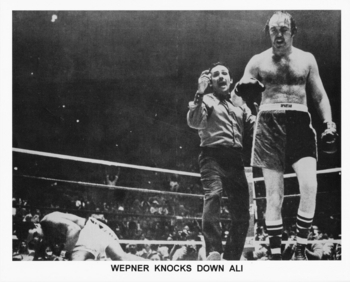
Wepner got a phone-call from a producer telling him about a new movie to be based on his life. He saw the première of ‘Rocky’ in New York and was bewildered. “The movie brought me into a trance, just like the Ali fight had brought Stallone into a trance,” says Wepner. “Rocky was bet-ter than I had anticipated, it told the story of my life.” In Philadelphia instead of Bayonne, the character of Rocky is, as Wepner used to be, a local hero, who is boxing in smoky cel-lars, never really making it, and raking in money for small-time Mafiosi; who, like Wepner, as white underdog stands no chance against the black and outspoken champion; who deals the blow sending his opponent to the canvas, who survives all 15 rounds, to loose the fight in the end, but to win the hearts of the fans; who has a half-blind coach, who is training in an obscure boxing club and who is also running through run-down industrial areas and jogging along the quays of a harbour.
Few scenes in the history of cinema are as famous as the one with Rocky sprinting on the steep steps leading to the Philadelphia Museum of Art. Having reached the top, Rocky is stretching his arms out in a triumphal gesture towards heaven. Nowadays, you will find a bronze Rocky-statue at that very spot, luring tens of thousands of tourists to Philadelphia every year.
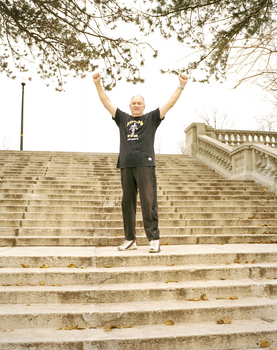
‘Rocky’ got the Oscar for best film. Wepner got nothing. For years on end, he was telling the tale that Stallone has paid him 70.000 dollar for the rights to use the story of his life. He was ashamed of the truth. Everything that had been promised to him by Stallone fell through. Just before they began to film ‘Rocky II’, he deleted some scenes during which Wepner was supposed to play his sparring partner, named Ching Webber. “Stallone consoled me time and again, reas-suring that the right role would surely show up,” says Wepner. But it never did. In 1985, they met again on a film set situated in a jail in New Jersey. Wepner had been caught with cocaine in his possession and was serving an 18 month sentence. Stallone was shooting the jailhouse-drama ‘Lock Up’ there and visited Wepner, who made him wait for half an hour.
Today, Wepner no longer bears a grudge. “Stallone deserves what he has,” he says. “He got it through a lot of hard work of his own, he’s clever and a great author.” The telephone rings. A client orders a case of vodka. Wepner is still in the liquor business. Three times per week, he is pumping weights, and he is commenting classical box-fights for TV. He has no desire to be a pensioner. “I am as fit as a teenager,” he says and calls his wife Linda, a voluptuous Italian with peroxide-blond hair. “She’s a princess,” says Wepner. “If there was no photographer around, she would still be in bed.” “I have lived a good life; when I drop dead tomorrow, then that’s fine, as I haven’t missed a thing.” He had three marriages and “millions of women.” Two girlfriends were sitting next to his wife at the ringside of the Ali-fight. He is driving a massive 60.000 dollar Cadillac – with ‘Champ’ written on its number-plate, a gift from a former Governor of New Jersey.


did chuck ever get into any fistfights? Was he the type of guy that would have met anyone for a fistfight as well?